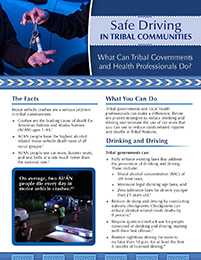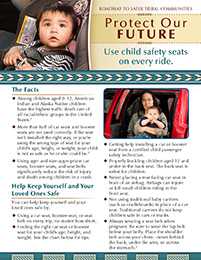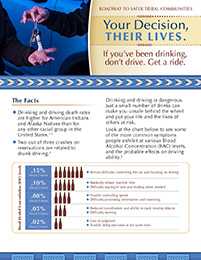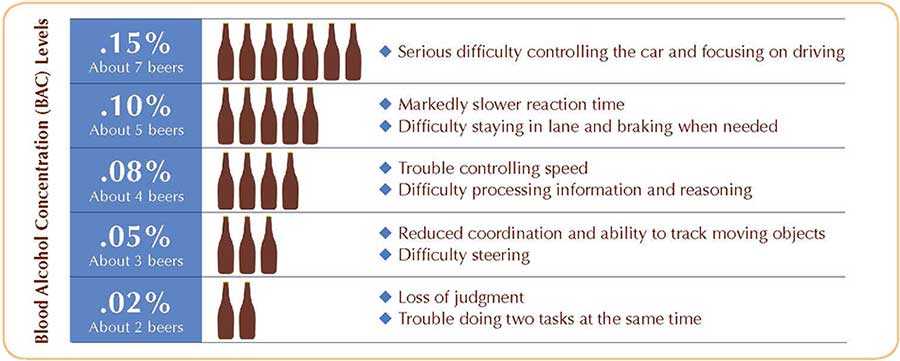Roadway to Safer Tribal Communities Toolkit
American Indians and Alaska Natives have the highest motor vehicle-related death rates of all racial and ethnic groups. However, crash-related injuries and deaths among members of tribal nations can be prevented.
The toolkit's fact sheets, posters, and video include important steps for road safety, including increasing child safety seat use, increasing seat belt use and decreasing alcohol-impaired driving.
Safe Driving In Tribal Communities: What Can Tribal Governments and Health Professionals Do?
The Facts
Motor vehicle crashes are a serious problem in tribal communities:
- Crashes are the leading cause of death for American Indians and Alaska Natives (AI/AN) ages 1–44.1
- AI/AN people have the highest alcohol-related motor vehicle death rates of all racial groups.2
- AI/AN people use car seats, booster seats, and seat belts at a rate much lower than the national rate.3
On average, two AI/AN people die every day in motor vehicle crashes.4
What You Can Do
Tribal governments and local health professionals can make a difference. Below are proven strategies to reduce drinking and driving and increase the use of car seats that you can use to reduce crash-related injuries and deaths in Tribal Nations.
Drinking and Driving
Tribal governments can:
- Fully enforce existing laws that address the prevention of drinking and driving. These include:
- Blood alcohol concentration (BAC) of .08 limit laws,
- Minimum legal drinking age laws, and
- Zero tolerance laws for drivers younger than 21 years old.5
- Reduce drinking and driving by conducting sobriety checkpoints. Checkpoints can reduce alcohol-related crash deaths by 9 percent.6
- Require ignition interlock use for people convicted of drinking and driving, starting with their first offense.7
- Restrict nighttime driving for teens to no later than 10 p.m. for at least the first 6 months of licensed driving.8
- Explore Community Guide supported strategies that may lead to a reduction in binge drinking.7
- Restrict vehicle passengers to no more than one during the first 6 months of a new driver’s licensed driving.8
Local health professionals can:
- Conduct screening and brief interventions for risky behaviors, such as using alcohol and drugs and driving while impaired.9
- Talk with patients about the dangers of drinking and driving. This includes reminding your patients to:
- Never drink and drive.
- Get a safe ride home or call a taxi if they drink.
- Stop friends from drinking and driving.
- Plan ahead when hosting a party where alcohol will be served. This includes:
- Making sure all guests designate and leave with a sober driver.
- Offering alcohol-free beverages.
Car Seats and Booster Seats
Tribal governments can:
- Partner with state and county police for car seat and booster seat education and enforcement.
- Provide education and incentives for the use of car seats and booster seats.
- Work toward ensuring that all children through at least age 8 travel properly buckled in an age- and size-appropriate safety seat to reduce injuries and save lives.10
Local health professionals can:
- Keep up to date on child passenger safety. You can learn more on our Child Passenger Safety web pages.
- Counsel parents and caregivers at each well-child check-up about:
- The importance of using age- and size- appropriate car seats, booster seats, and seat belts on every trip, and
- The correct time to move a child to the next seat type or seat belt.

Seat Belts
Tribal governments can:
- Consider using proven interventions to reduce injuries, which include increasing seat belt use through primary enforcement of seat belt laws that cover everyone in the car.
Local health professionals can:
- Counsel patients of all ages about the importance and effectiveness of buckling up.
- Encourage caregivers to make sure that children travel properly buckled in the back seat in an age- and size-appropriate car seat or booster seat, or with a seat belt to reduce injuries and save lives.10
What’s Working in Tribal Communities
The Centers for Disease Control and Prevention’s Injury Center funded several tribes to tailor, implement, and evaluate evidence-based interventions to reduce motor vehicle-related injury and death in their communities. The following pilot programs successfully decreased incidences of drinking and driving and increased the use of child safety seats and seat belts.
Decreasing Drinking and Driving
The San Carlos Apache Tribal Motor Vehicle Injury Prevention Program focused on reducing drunk driving among tribal members. Key parts of the program included media campaigns, sobriety checkpoints, enhanced law enforcement, and local events.
The results:
The San Carlos Tribal community experienced an increase in total driving under the influence (DUI) arrests and a decrease in the number of vehicle crashes after implementing a .08 BAC policy.11
Increasing Child Safety Seat Use
The Yurok Tribe in California implemented the California Rural Indian Health Board’s Buckle Up Yurok Program, which comprises community education clinics, a media campaign, car seat checks, and distribution events.
The results:
In 2012, a new primary seat belt and child safety seat law was implemented, which helped increase child safety seat use and protection for all motor vehicle occupants. More than 250 car seats, with education on how to properly use the seats, were distributed over 4 years. From 2011 to 2014, car seat use increased 34%.
Increasing Seat Belt Use
The Hopi Tribe improved collaboration with law enforcement to strengthen the existing seat belt law. A successful media campaign raised awareness among tribal members about the importance of buckling up.
The results:
Driver seat belt use increased 33% and passenger seat belt use increased 50% between 2011 and 2014.
References
- CDC. Web-based injury statistics query and reporting system. Atlanta, GA: U.S. Department of Health and Human Services, CDC; 2014. Available at http://www.cdc.gov/injury/wisqars. Accessed January 22, 2015.
- Naimi TS, Cobb N, Boyd D, Jarman DW, Espey D, Snesrud P, Chavez P. Alcohol-attributable deaths and years of potential life lost among American Indians and Alaska Natives—United States, 2001–2005. MMWR 2008;57(34):938–941.
- LeTourneau RJ, CE Crump, Bowling JM, Kuklinski DM, Allen CW. Ride Safe: A child passenger safety program for American Indian and Alaska Native children. Maternal Child Health 2008. DOI 10.1007/s10995-008-0332-6.
- CDC. NCHS mortality, CDC WISQARS 2009. Atlanta, GA: U.S. Department of Health and Human Services. Available at http://www.cdc.gov/injury/wisqars. Accessed May 22, 2015.
- Shults RA, Sleet DA, Elder RW, Ryan GW, Sehgal M. Association between state-level drinking and driving countermeasures and self-reported alcohol-impaired driving. Injury Prevention 2002;8:106–10.
- Bergen G, Pitan A, Qu S, Shults RA, Chattopadhyay SK, Elder RW, Sleet DA, Coleman HL, Compton RP, Nichols JL, Clymer JM, Calvert WB, Community Preventive Services Task Force. Publicized sobriety checkpoint programs: a Community Guide systematic review. Am J Prev Med 2014;46 (5):529-39.
- Guide to Community Preventive Services. Preventing excessive alcohol consumption: increasing alcohol taxes. Available at http://www.thecommunityguide.org/alcohol/ increasingtaxes.html. Accessed May 19, 2015.
- CDC. Parents are the key to safe teen drivers. Atlanta, GA: U.S. Department of Health and Human Services, CDC; 2014. Available at http://www.cdc.gov/ParentsAreTheKey. Accessed May 19, 2015.
- Higgins-Biddle, J., Dilonardo, J. (2013, September). Alcohol and highway safety: Screening and brief intervention for alcohol problems as a community approach to improving traffic safety. Washington, DC: National Highway Traffic Safety Administration. DOT HS 811 836.
- CDC Vital Signs. Child passenger safety. Atlanta, GA: U.S. Department of Health and Human Services, CDC; 2014. Available at Available at http://www.cdc.gov/VitalSigns/ childpassengersafety . Accessed May 19, 2015.
- Piland EF, Berger LR, Naumann RM. Economic Costs of Motor Vehicle Crashes and Economic Benefits of Prevention for the San Carlos Apache Tribe. The IHS Primary Care Provider 2010; 35:12.
The Centers for Disease Control and Prevention’s National Center for Injury Prevention and Control and the Indian Health Service Injury Prevention Program work in partnership with American Indian/Alaska Native communities to implement proven programs.
Buckle Up! Every Person, Every Seat, Every Time.
The Facts
- American Indians and Alaska Natives are more at risk for getting injured or killed in a car crash than other Americans.1
- Three out of every four passengers who died in car crashes on reservations were not wearing seat belts at the time of the crash.2
- Wearing seat belts even when the car or truck has air bags, because airbags are designed to enhance the protection of seat belts.3
Seat belts reduce the risk of getting hurt or killed in a car crash by about half.
Help Keep Yourself and Your Loved Ones Safe
You can help keep yourself and your loved ones safe by:
- Wearing a seat belt every time you ride in a car.
- Buckling up the right way.
- The lap belt goes across the hips, below the stomach.
- The shoulder belt goes across the middle of the chest and over the shoulder.
- Never put the shoulder belt behind your back or under your arm.
- Wearing seat belts even when the car or truck has air bags. Air bags are made to work with seat belts, not by themselves.
- Never riding in the bed of a truck.
- Never using a seat belt to buckle more than one person at a time.
- Wearing seat belts throughout pregnancy.
- Place the lap portion of the belt under the belly, across the hips, and high on the thighs.
- Place the shoulder belt across the chest and over the shoulder.
- Never place straps directly across the stomach.
- Buckling older children in a booster seat until the seat belt fits them properly. Seat belts fit properly when the lap belt lays across the upper thighs (not the stomach) and the shoulder belt lays across the chest (not the neck).
- Using seat belt extenders if the seat belt is too small for you. You can buy these from car dealers and manufacturers.
References
- Centers for Disease Control and Prevention. Injury mortality among American Indian and Alaska Native children and youth—United States, 1989–1998. MMWR Morb. Mortal. Wkly. Rep., 52 (30) (2003), pp. 697–701.
- U.S. Department of Transportation, National Highway Traffic Safety Administration. Fatal motor vehicle crashes on Indian reservations 1975–2002. April 2004. DOT HS 809 727.
- National Highway Traffic Safety Administration. Final regulatory impact analysis amendment to Federal Motor Vehicle Safety Standard 208. Passenger car front seat occupant protection. Washington, DC: U.S. Department of Transportation, National Highway Traffic Safety Administration; 1984. DOT-HS-806-572.
The Centers for Disease Control and Prevention’s National Center for Injury Prevention and Control and the Indian Health Service Injury Prevention Program work in partnership with American Indian/Alaska Native communities to implement proven programs.
Protect Our Future: Use Child Safety Seats on Every Ride.
The Facts
- Among children aged 0– 12, American Indian and Alaska Native children have the highest traffic death rate of all racial/ethnic groups in the United States.1
- More than half of car seats and booster seats are not used correctly. If the seat isn’t installed the right way, or you’re using the wrong type of seat for your child’s age, height, or weight, your child is not as safe as he or she could be.2
- Using age- and size-appropriate car seats, booster seats, and seat belts significantly reduce the risk of injury and death among children in a crash.
Help Keep Yourself and Your Loved Ones Safe
You can help keep yourself and your loved ones safe by:
- Using a car seat, booster seat, or seat belt on every trip, no matter how short.
- Finding the right car seat or booster seat for your child’s age, height, and weight. See the chart below for tips.
- Getting help installing a car or booster seat from a certified child passenger safety technician.
- Properly buckling children aged 12 and under in the back seat. The back seat is safest for children.
- Never placing a rear-facing car seat in front of an airbag. Airbags can injure or kill small children riding in the front seat.
- Not using traditional baby carriers (such as cradleboards) in place of a car seat. Traditional carriers do not keep children safe in cars or trucks.
- Always wearing a seat belt when pregnant. Be sure to wear the lap belt below your belly. Place the shoulder belt across your chest—never behind the back, under the arm, or across the stomach.3
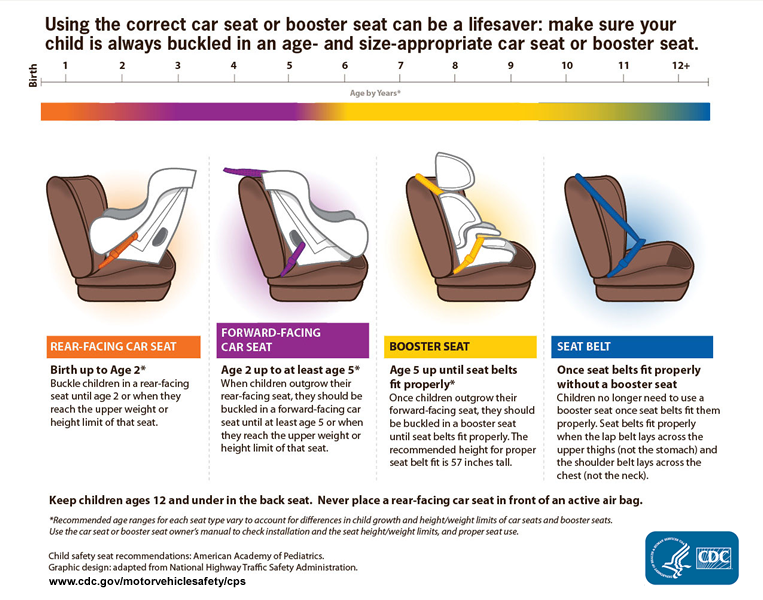
Do you need help choosing or installing your car seat? Find a child passenger safety technician at cert.safekids.org for assistance.
Related Pages
References
- CDC. Web-based injury statistics query and reporting system. Atlanta, GA: U.S. Department of Health and Human Services, CDC; 2015. Available at http://www.cdc.gov/injury/wisqars. Accessed March 13, 2015.
- Lapidus J, Lutz T, Ebel B, Bigback K, Smith N. Native children always ride safe (Native CARS): Aggregate report. Portland, OR: Northwest Portland Area Indian Health Board, December 2009.
- National Highway Traffic Safety Administration. Seatbelts and pregnancy brochure, 2002. Available at http://www.safercar.gov/parents/SeatBelts/Pregnancy- Seat-Belt-Safety.htm. Accessed May 27, 2015.
The Centers for Disease Control and Prevention’s National Center for Injury Prevention and Control and the Indian Health Service Injury Prevention Program work in partnership with American Indian/Alaska Native communities to implement proven programs.
Your Decision, Their Lives. If You've Been Drinking, Don't Drive. Get a Ride.
The Facts
Drinking and driving death rates are higher for American Indians and Alaska Natives than for any other racial group in the United States.1-3
Two out of three crashes on reservations are related to drunk driving.4
Drinking and driving is dangerous. Just a small number of drinks can make you unsafe behind the wheel and put your life and the lives of others at risk.
Look at the chart below to see some of the more common symptoms people exhibit at various Blood Alcohol Concentration (BAC) levels, and the probable effects on driving ability.5
Learn more about the effects of blood alcohol concentration (BAC)
Keep Your Community Safe
You can help keep yourself, your loved ones, and your community safe from drinking and driving by:
- Choosing not to drink and drive.
- Getting a ride if you drink.
- Stopping friends from drinking and driving.
Talk with your health care provider if drinking is causing problems with your health, safety, work, or friends and family.
Related Pages
References
- Voas RB, Tippets AS, Fisher DA. Ethnicity and alcohol related fatalities: 1990 to 1994. Landover, MD: Pacific Institute for Research and Evaluation; 2000. DOT HS 809 068.
- Naimi TS, Cobb N, Boyd D, Jarman DW, Espey D, Snesrud P, Chavez P. Alcohol-attributable deaths and years of potential life lost among American Indians and Alaska Natives—United States, 2001–2005. MMWR 2008; 57(34):938–941.
- U.S. Department of Transportation, National Highway Traffic Safety Administration. Traffic safety facts 2006 Data: Race and Ethnicity August 2009. DOT HS 810 995.
- U.S. Department of Transportation, National Highway Traffic Safety Administration. Fatal motor vehicle crashes on Indian reservations 1975–2002. April 2004. DOT HS 809 727.
- Adapted from The ABCs of BAC, National Highway Traffic Safety Administration, 2005, and How to control your drinking, WR Miller and RF Munoz, University of New Mexico, 1982.
The Centers for Disease Control and Prevention’s National Center for Injury Prevention and Control and the Indian Health Service Injury Prevention Program work in partnership with American Indian/Alaska Native communities to implement proven programs.
Video: A Killer in Indian Country
This video highlights important steps for road safety, including increasing child safety seat use, increasing seat belt use and decreasing alcohol-impaired driving.
Roadway to Safer Tribal Communities Posters
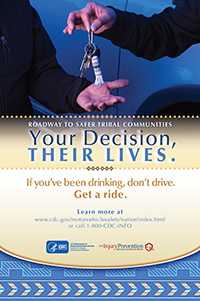

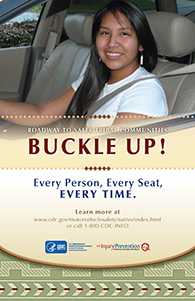
Additional Resources
- Page last reviewed: November 2, 2016
- Page last updated: November 2, 2016
- Content source:
- Centers for Disease Control and Prevention,
- National Center for Injury Prevention and Control,
- Division of Unintentional Injury Prevention


 ShareCompartir
ShareCompartir
